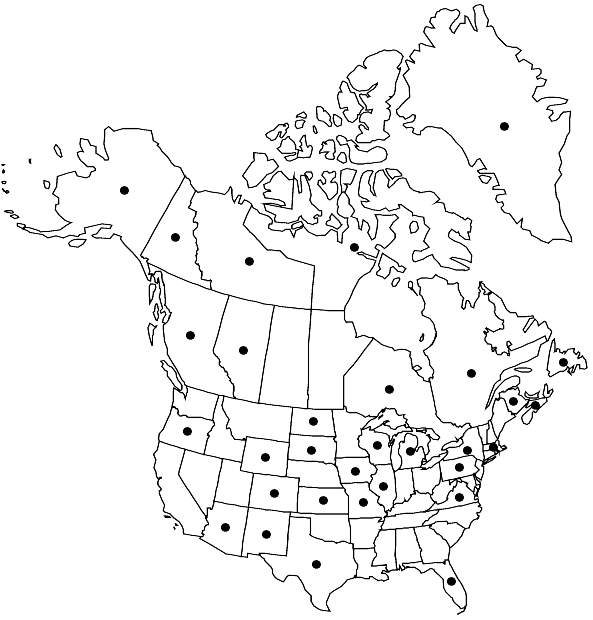Didymodon rigidulus var. rigidulus
Stem-leaves appressed to weakly spreading when dry, spreading when moist, oblong-lanceolate, ellipticlanceolate or long-triangular, base not or weakly broadened, oval; costa usually short-excurrent and blunt; proximal cells shortrectangular or quadrate; distal laminal cells smooth to weakly papillose, quadrate, with quadrate lumens, distal lamina 2-stratose at apex or along margins; gemmae often present in distal leaf-axils. Peristome teeth short and straight to very weakly twisted.
Phenology: Capsules mature May–Sep.
Habitat: Calcareous rock, boulders, cliff faces, soil, outcrops, sinks, ledges, tufa
Elevation: low to moderate elevations (60-500 m)
Distribution

Greenland, Alta., B.C., N.B., Nfld. and Labr. (Nfld.), N.W.T., N.S., Nunavut, Ont., Que., Yukon, Alaska, Ariz., Colo., Fla., Ill., Iowa, Kans., Mass., Mich., Mo., N.Mex., N.Y., N.Dak., Oreg., Pa., S.Dak., Tex., Va., Wis., Wyo., Mexico, South America, Europe, n Africa
Discussion
Variety rigidulus is relatively uniform in eastern North America, with slightly spreading, oblong-lanceolate to long-triangular leaves with thickened distal margins, percurrent or short-excurrent costa, thick-walled cells, gemmae usually present, and the peristome straight or only weakly twisted. When the distal margins are not 2-stratose or only slightly so, it can be difficult to identify, especially as it may occasionally have the costal groove of D. vinealis, and large specimens may similarly have guide cells in two layers. It intergrades in the West with the other varieties, and propagula are commonly absent. The typical variety, with distinctive oblong-lanceolate leaf shape and propagula, is rare in the Arctic, and though generally hygrophilic may be found on merely moist substates in southern states. From D. vinealis in the narrow sense, this variety may be distinguished by the combination of stiff, long-triangular or oblong-lanceolate leaves, usual presence of many gemmae in the leaf axils and the commonly yellow-green color in water (sometimes blackish green, rarely reddish below) and yellow or yellow-orange color in KOH. Commonly misidentified as this variety is the western D. tectorum, which also has axillary gemmae, but differs by the costa narrowly excurrent from a blunt leaf apex, and a rectangular (not elliptical) leaf base.
Selected References
None.
Lower Taxa
"um" is not declared as a valid unit of measurement for this property."um" is not declared as a valid unit of measurement for this property.